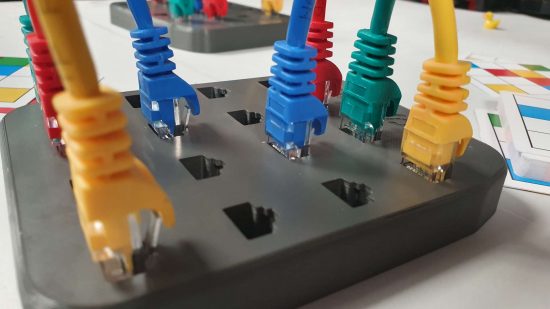Speedport is an upcoming dexterity board game by publisher Loodo Ninja, which sees players race to plug colored ethernet cables into a plastic board to match the pattern shown on a scoring card. As a former IT guy, I couldn’t turn down a review copy when it was offered: but I never expected that it might have real promise as a board game for education.
My testing partner for most family board games is my eight year old daughter, who did not take well to the rapid, dexterity-based gameplay. If my daughter doesn’t like a family game, that’s usually the end of the road for me covering it. But I happened to bring Speedport along to my local wargames club and, before my main game of the evening, gave it another spin with a chum and his son.
This friend – who prefers to remain anonymous, so I’ll call him Randolph Hooper Entwhistle – works in a high school in a deprived area, and runs several lunchtime clubs. “This could be really interesting with the kids I teach” he said, eyes lighting up, clearly seeing potential for the game that I couldn’t.

Randolph explained what he thought students might get from the game. Pinching and removing the ethernet cables from the board would offer “more practice with their fine motor control”, helping with “handwriting legibility and speed”; apparently a big problem for kids brought up on touchscreen devices rather than tactile toys.
He also had hopes that one group of kids “who are not managing their behaviour in mainstream classes” would be able to “practise managing their frustrations without actually having an argument”. Not always the outcome of a board game, as anyone who remembers Christmas Monopoly games can attest, but certainly a noble goal.
With dim prospects of testing the game at home any more, I lent it to Randolph. One week later, he gave me the results: “It was exactly what I wanted to see”.
A mix of boys and girls, with very different reasons for being in lunchtime clubs, tested the game: four 13-14 year olds who struggle with behaviour in class; six academically strong 14-15 years old in a lunch time debate club; and four 13-14 year olds who stay in at break times to avoid sensory overload from the playground.
They all “really enjoyed the game”, Randolph says, and picked it up “within seconds”. For the group that struggles with classroom behaviour, he says “it’s the only time I’ve seen all four students stay within proximity to each other, engaged in a single activity, and not argue”. Some pupils found the game “fun but frustrating”, but they “remained focused”. The debate club called the game “Twister without any moving about”.
Speedport has a single paragraph of rules – the first sentence of this article explains the whole game – which contributed to how quickly the kids grasped it. It’s not a deep game: “pretty quickly a single person was obviously a little faster than the others and so became dominant in ‘winning’ cards”, Randolph explained, a problem I faced when playing with my daughter.
But because the game rules are so minimal, it also proves very easy to adapt, which proved to be a real positive in an education setting. The kids in the debate club started “figuring out new and different ways to play”, with one boy “coming up with an idea where two boards would be combined to create a ‘dual pattern’ but with the additional rule that each cable should start and finish on different boards”.
A colleague has since nabbed the game from Randolph to use with a lunchtime club she runs for students with social anxiety and special educational needs, aged 11-15. “It’s perfect in that setting as it’s easy to grasp, quick to set up and put away and allows pupils to play with as much or little interaction as they are comfortable with”, Randolph explains.

If you want to pick up your own copy of Speedport – or its slower, strategy board game cousin, Clickport – it’s currently up for grabs on Kickstarter.
This isn’t the write up I expected to give for Speedport – Wargamer is not a specialist education site, though we will always shout about the benefits that kids board games can have for skills like reading, writing, turn-taking, co-operation, planning, and losing and winning graciously. I’m very glad that someone more knowledgeable than me was able to test the game, and especially glad that it’s given so many kids so much fun.
If you’re an educator, Scout leader, social worker, or anyone else who works with groups of kids, and want to learn more about board games, check out our introduction to the different board game types, and then our guide to the best board games.


